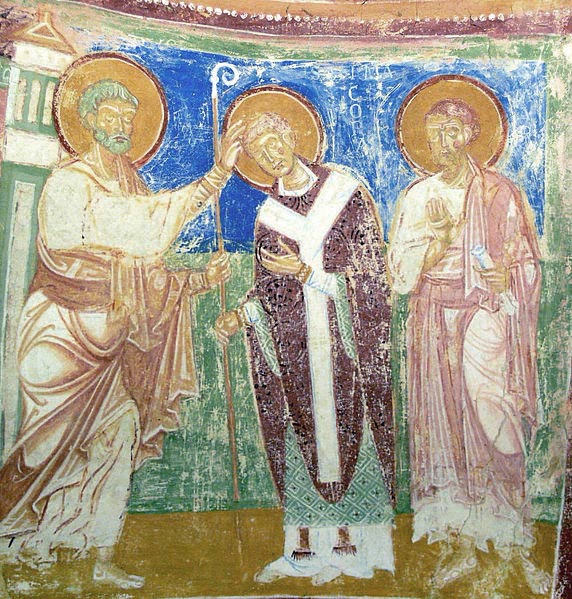Succession: From the Holy Apostles to Bishop Salazar to Cardinal Tagle

The Protestant traditions (Lutheran, Calvinist, Baptist, Methodist, et al) and Born-Again Christian fellowships do not have an altar. They have no sacrifice, no victim, and no priesthood. The center of weekly service is the Word of God, sola scriptura – their minister being a preacher and not a priest.
Uniquely, the Catholic minister assumes a triple function, to wit: He is an ordained priest that offers the Holy Sacrifice of the Mass, a prophet sent to preach the Gospel (Mark 16:15), and a shepherd tasked with the pastoral care of the souls, cura animarum.
Akin to their Anglican brethren, the Aglipayan Church has its own “priesthood” but is detached from the Apostolic succession and ministry. Only in the Catholic Church could one find a continuous lineage of bishops that stretched back to the Holy Apostles during the time of Jesus.
Check the recorded historical succession of every bishop and discover how each one of the Catholic bishops today is validly ordained by a successor of one original Apostles of Jesus Christ – thus assuring the authentic continuity of the Twelve Apostles’ own ministry in the new millennium.
No other institution on Earth can claim such an authenticated historical succession. In Manila, Dominican Bishop Salazar was succeeded by the Franciscan friar, Most Rev. Ignacio Santibáñez, OFM (1512-1598), who served as the first Archbishop of Manila (1595-1598), then by Dominican friar, Most Rev. Miguel de Benavides, OP, the second Archbishop of Manila, and so on until the present Archbishop, His Eminence Antonio Luis Cardinal Tagle.
Collective successors of the Apostles
As earlier indicated, the Apostolic succession is also history: Recorded, well preserved, and archived (www.catholic-hierarchy.org). Guaranteed to operate for two thousand years and beyond, the APOSTOLIC SUCCESSION is a fundamental building block of the Catholic tradition, said Pope Francis (April 21, 2013).
The present college of bishops descends from the College of the Apostles, the closest circle of chosen friends of Jesus. Does it mean that our bishops and priests today are tasked to continue what the Apostles Jude, John, Bartholomew, Andrew, James, and Peter did in their lifetime? Absolutely! Hence, the entitlement of being the “One, Holy, Catholic, and Apostolic Church.”
Because of this, the Catholic Church is the depository of the power of the keys, of opening or closing God’s wellspring of invisible grace through the visible Sacraments.
For one, our Mother Church has the sacred altar where Jesus is sacrificed in the Holy Mass everyday through the instrumentality of the Holy Priesthood. As the Prophet Malachi alluded in the Old Testament: “From the rising of the sun even to its setting… they bring sacrifice to my name and a pure offering” (1:11).
China in the mind of the first Manila Bishop
NOW, THIS APOSTOLIC SUCCESSION, authentic and historical, reached the Philippines when Manila was created a diocese in 1579 and Fray Domingo de Salazar, OP, was consecrated and installed as its first bishop.
His acceptance of becoming the first Philippine bishop was grounded on his personal thought that the Philippines could be his jumping board to go to China. His true passion was to become a missionary, saying that “one of the reasons which made me accept this bishopric was the fact that these Islands are near China… For a long time I have had the conversion of that kingdom at heart…”
From Spain, he set out for Manila via Acapulco, taking with him twenty Dominicans, twelve of whom died before reaching Mexico. Of the remainders, only one of the Order of Preachers was able to continue the journey to the Philippines himself – as all the others perished on the dangerous sea transit to Manila crossing the Pacific.
In his first visit, Saint John Paul II did not fail to mention the heroism and evangelical commitment of Bishop Salazar. The Holy Father said: “Here he preached the Good News not only to the people of these islands but also to his compatriots, in order to persuade them that the Lord’s Gospel means justice and not slavery for the people they had come to colonize” (Cebu City, 19 February 1981).
The One-Holy-Catholic-and-Apostolic Church is now in the Philippines (“a great Catholic nation” – Pope Francis) after the authentic continuity of the Twelve Apostles’ own ministry reached our shores from Spain via Acapulco in 1579. Deo gratias!
Jose Mario Bautista Maximiano (jomaximiano@gmail.com) is the author of 24 PLUS Contemporary People: Signs of the Times All Pointing to God (Claretian, 2019).

